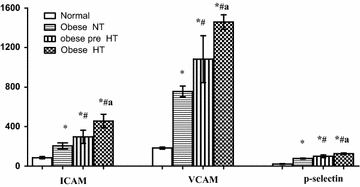Association of cardiac NT pro-β-type natriuretic peptide with metabolic and endothelial risk factors in young obese hypertensive patients: a perspective on the hypothalamic pituitary adrenal axis activation
- PMID: 27478508
- PMCID: PMC4966595
- DOI: 10.1186/s13098-016-0164-2
Association of cardiac NT pro-β-type natriuretic peptide with metabolic and endothelial risk factors in young obese hypertensive patients: a perspective on the hypothalamic pituitary adrenal axis activation
Abstract
Background: In practice, there is increasing recognition of the importance of hypothalamic pituitary adrenal axis in the cardiovascular disease progression. The association of brain natriuretic peptide with obesity and characteristics of the metabolic syndrome in adults and aged patients is well established, but that in pediatrics needs thorough elucidation.
Aim: The aim of this study was to assess the association of hypothalamic pituitary adrenal axis mediators (cortisol and aldosterone) with plasma NT-pro β-type natriuretic peptide (NT-proBNP) levels on metabolic, immune-inflammatory and endothelial markers in young obese pediatric patients.
Methods: This is achieved by recruitment of 60 young (13-17 years) obese pediatric cohorts who are further subclassified according to their stage of hypertension; normotensive, prehypertensive and hypertensive patients.
Results: The study showed significant differences in the metabolic parameters (glucose, insulin and HOMA-index) among the three obese young patient groups. Levels of cortisol and aldosterone, as well as NT-proBNP levels are positively associated with characteristics of the metabolic syndrome; blood pressure, BMI, HOMA index in all three obese groups. However, their association to the lipid profile was insignificant. These increases aligned harmonically with the assessed immune-inflammatory markers; CRP, TNF-α, and IL-23, as well as levels of sICAM, sVCAM and p-selectin, reflecting the involvement of mast cells and inflammatory effects on the vascular endothelium. ROC analysis revealed their beneficial addition as promising biomarkers for a better prognostic profile of hypertension-induced cardiovascular risk.
Conclusion: Early detection of NT-proBNP, cortisol and aldosterone levels in pre-hypertension stage added to the immune-inflammatory mediators may improve the coronary risk assessment in young Egyptian patients.
Keywords: Aldosterone; Cortisol; Endothelial markers; Hypertension; Metabolic syndrome; NT-proBNP.
Figures


Similar articles
-
N-terminal pro-B-type natriuretic peptide is inversely associated with metabolic syndrome in hypertensive patients.Am J Med Sci. 2014 Sep;348(3):210-4. doi: 10.1097/MAJ.0000000000000234. Am J Med Sci. 2014. PMID: 24736765
-
Early cardiac abnormalities and serum N-terminal pro B-type natriuretic peptide levels in obese children.J Pediatr Endocrinol Metab. 2011;24(9-10):723-6. doi: 10.1515/jpem.2011.285. J Pediatr Endocrinol Metab. 2011. PMID: 22145463
-
Gender dimorphic associations between N-terminal pro-brain natriuretic peptide, body mass index and blood pressure in children and adolescents.Horm Res Paediatr. 2010;73(5):341-8. doi: 10.1159/000308166. Epub 2010 Apr 14. Horm Res Paediatr. 2010. PMID: 20389104
-
Associations between circulating N-terminal pro-Brain Natriuretic Peptide (NT-proBNP) and adiponectin concentrations depend on obesity level in female adolescents: gender dimorphic findings.Horm Metab Res. 2009 Nov;41(11):829-33. doi: 10.1055/s-0029-1233459. Epub 2009 Aug 10. Horm Metab Res. 2009. PMID: 19670155
-
Incremental value of high-sensitivity C-reactive protein and N-terminal pro-B-type natriuretic peptide for the prediction of postoperative cardiac events in noncardiac vascular surgery patients.Coron Artery Dis. 2009 May;20(3):219-24. doi: 10.1097/MCA.0b013e3283219e47. Coron Artery Dis. 2009. PMID: 19322079
Cited by
-
Weathering the Storm: How Age and Biologics Influence the COVID-19 Cytokine Surge.Pathogens. 2025 Apr 3;14(4):346. doi: 10.3390/pathogens14040346. Pathogens. 2025. PMID: 40333142 Free PMC article. Review.
References
-
- Olsen MH, Hansen TW, Christensen MK, Gustafsson F, Rasmussen S, Wachtell K, Borch-Johnsen K, Ibsen H, Jorgensen T, Hildebrandt P. N-terminal pro brain natriuretic peptide is inversely related to metabolic cardiovascular risk factors and the metabolic syndrome. Hypertension. 2005;46:660–666. doi: 10.1161/01.HYP.0000179575.13739.72. - DOI - PubMed
LinkOut - more resources
Full Text Sources
Other Literature Sources
Research Materials
Miscellaneous

